Cambridge Etchings, A Synopsis - Part II
by Mark A. Nye
Issue No. 174 - October 1987
The etchings discussed this month will be found either in the 1930-34 Catalog Reprint or in the 1949-53 Catalog Reprint.
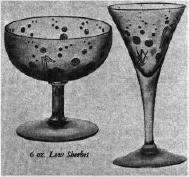 |
VICHY: Shown in the 1934 Cambridge catalog supplement on #3129 stemware. Vichy was discontinued prior to 1940 only to be revived during the early 1950s for use on a barware line. Not often seen today, Vichy or etching #765 was probably used only on crystal blanks. One distinction about Vichy is that it was one of the few etchings to be used on the #3011 or Nude Stemware line. |
 |
CHINTZ: Another etching from the mid 1930s that was discontinued before 1940. Chintz or #766 apparently never achieved a great popularity as little is seen today. While there are occasional pieces and stemware etched Chintz, a complete dinnerware set is unlikely and production in color although not unknown, was probably less than that done on crystal blanks. |
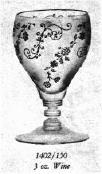 |
ELAINE: The Elaine or #762 etching was, at one time, available on more blanks than Rosepoint, but its popularity was eventually surpassed by the latter etching. Brought out in 1933 and in the Cambridge catalog until 1954, there are at least six lines of Elaine etched stemware and three of dinnerware. Primarily placed onto crystal blanks, Elaine will be found with a gold edge and gold encrusted in addition to plain etched crystal blanks. On rare occasions an Elaine etched colored blank will be found. |
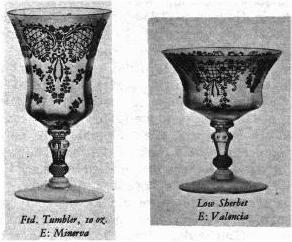 |
MINERVA AND VALENCIA: Minerva #763 and Valencia #761 were added to the Cambridge line in 1933 and remained available thru 1939. Despite the fact relatively few pieces of these etchings are seen today, both were placed on complete stemware and dinnerware lines, #3400, Gadroon and Tally-Ho. Production of these etchings on colored blanks was limited and such pieces are seen even less frequently than crystal pieces. Minerva and Valencia were gold encrusted as well as being available plain and plain with a gold edge. |
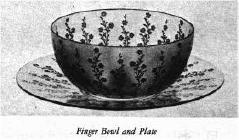 |
MARLENE: A seldom seen etching from the mid 1930s, Marlene appears to have had a short production run. Shown in a 1936 catalog supplement on stemware and a finger bowl, Marlene, also known as #767, remains an obscure etching, unseen by most collectors. |
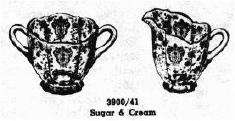 |
ROSEPOINT: Rosepoint, the premier Cambridge etching, was introduced to the trade in November 1934 and continued to be sold until the demise of the company. Imperial attempted to produce Rosepoint and for a while during the 1960s did offer a short line; however, it was not successful and was soon dropped from the Imperial catalog. The quality of the Imperial produced Rosepoint was not equal to that of the original and can be distinguished by its lack of depth. Produced in full lines of dinnerware and stemware, Rosepoint, due to its great popularity, was probably placed on more blanks than any other Cambridge etching and most any item produced by Cambridge after 1935 may have been etched Rosepoint. Rosepoint, while primarily placed on crystal blanks and then sold plain, or further decorated with gold, was done on a limited extent of colored blanks. Pieces are known in carmen, amber and ebony gold encrusted. |
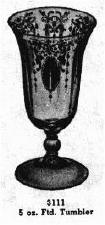 |
CANDLELIGHT: After its introduction circa 1936, Candlelight continued to be offered by Cambridge until 1952-53. While there are three stemware lines etched Candlelight, apparently there is not a complete Candlelight dinnerware set since a dinner plate is not known. Not available in the transparent colors, Candlelight will be found plain, gold encrusted or with a gold edge on crystal blanks and to a limited extent, gold encrusted on Crown Tuscan. |
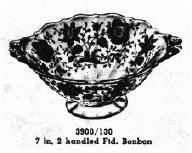 |
WILDFLOWER: Brought out in 1938, Wildflower was one of the three major etchings, the other two being Chantilly and Rosepoint. Still in production when the factory closed for the last time, Wildflower or etching #773 as it is also known, was used on the two dinnerware lines, #3400 and #3900 and three stemware lines, #3121, #3725 and Pristine. However, most of the Wildflower stemware found today is from the #3121 line and it appears very little Pristine and #3725 were decorated with this etching. While primarily found on crystal blanks, pieces in gold krystol, etched Wildflower are known. Wildflower, like many of the previous etchings was done plain, gold encrusted and with a gold edge. This etching is somewhat similar to an infrequently seen earlier design and one that is on occasion, referred to as "early Wildflower." However, there should be little confusion between the two patterns since the blanks used for the early etching will clearly identify it |
